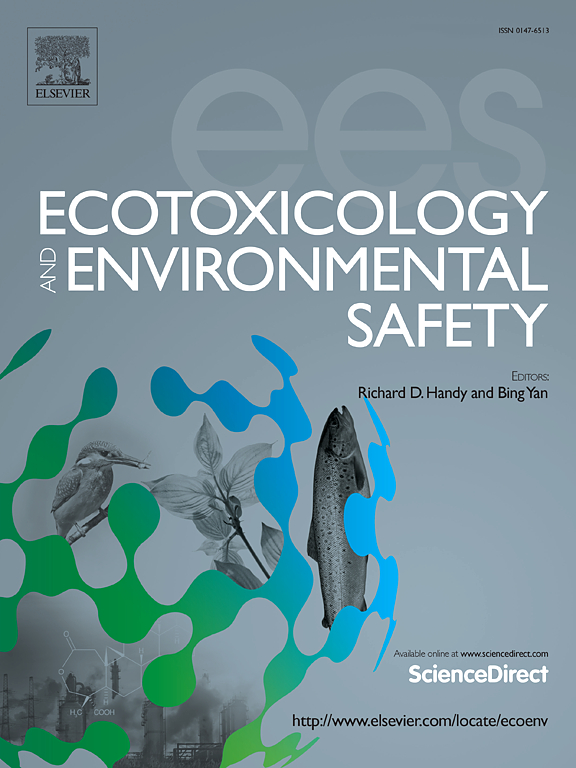Single cell RNA sequencing reveals the reshaping effect of perfluorooctanoic acid on the intestinal microenvironment of mice
IF 6.2
2区 环境科学与生态学
Q1 ENVIRONMENTAL SCIENCES
引用次数: 0
Abstract
Perfluorooctanoic acid (PFOA), a prevalent perfluorinated compound pollutants, has been implicated in the development of various gastrointestinal disorders. However, the specific PFOA-induced intestinal microenvironment alterations remain poorly characterized. In this study, we established a chronic PFOA toxicity model in C57BL/6 mice of both sexes through exposure to PFOA at doses of 0, 1, 5, and 10 mg/kg/day. Single-cell RNA sequencing (scRNA-seq) was performed on the small intestine tissues from female mice, and key findings were validated through flow cytometry and immunohistochemistry. Histopathological analysis revealed that PFOA induced intestinal damage in both sexes, with a more severe impact observed in female mice. scRNA-seq analysis demonstrated that PFOA treatment triggered abnormal proliferation of intestinal epithelial cells, particularly the expansion of Adahigh enterocyte cells, suggesting their potential role in injury repair process. Furthermore, PFOA exposure induced significant remodeling of the intestinal immune microenvironment, characterized by decreased overall lymphocyte infiltration, heightened activation of remaining cytotoxic CD8+ T cells, and a notable increase in proliferative CD8+ T cells. A significant reduction in FOXP3+ regulatory T cells further contributed to a pro-inflammatory shift within the T cell population. Cell-cell interaction analysis revealed enhanced macrophage-CD8+ T cell communication via the CCR1-CCL5 axis, suggesting a synergistic role in driving inflammatory responses. This study presents a comprehensive analysis of PFOA-induced intestinal microenvironment remodeling at single-cell resolution, providing novel insights into the pathophysiological mechanisms underlying PFOA-associated intestinal diseases.
Synopsis
Minimal research exists on PFOA-induced intestinal microenvironment changes. The study shows that abnormal hyperplasia and dysfunction of intestinal epithelial cell, along with immuno microenvironment dysregulation, create an inflammatory environment, potentially linked to PFOA-induced systemic toxicity.
单细胞RNA测序揭示了全氟辛酸对小鼠肠道微环境的重塑作用
全氟辛酸(PFOA)是一种普遍存在的全氟化合物污染物,与各种胃肠道疾病的发生有关。然而,pfoa引起的肠道微环境改变的特异性特征仍然很差。本研究通过0、1、5和10 mg/kg/d剂量的PFOA暴露,建立了C57BL/6小鼠的慢性PFOA毒性模型。对雌性小鼠小肠组织进行了单细胞RNA测序(scRNA-seq),并通过流式细胞术和免疫组织化学验证了关键发现。组织病理学分析显示,PFOA在两性小鼠中均引起肠道损伤,雌性小鼠的影响更为严重。scRNA-seq分析表明,PFOA处理引发肠上皮细胞异常增殖,特别是Adahigh肠上皮细胞的扩增,提示其在损伤修复过程中的潜在作用。此外,PFOA暴露诱导了肠道免疫微环境的显著重塑,其特征是整体淋巴细胞浸润减少,剩余细胞毒性CD8+ T细胞活化增加,增殖性CD8+ T细胞显著增加。FOXP3+调节性T细胞的显著减少进一步促进了T细胞群中的促炎转移。细胞-细胞相互作用分析显示,通过CCR1-CCL5轴,巨噬细胞- cd8 + T细胞通讯增强,提示在驱动炎症反应中具有协同作用。本研究在单细胞分辨率上全面分析了pfoa诱导的肠道微环境重塑,为pfoa相关肠道疾病的病理生理机制提供了新的见解。关于pfoa引起的肠道微环境变化的研究很少。该研究表明,肠道上皮细胞异常增生和功能障碍,以及免疫微环境失调,会产生炎症环境,可能与pfoa诱导的全身毒性有关。
本文章由计算机程序翻译,如有差异,请以英文原文为准。
求助全文
约1分钟内获得全文
求助全文
来源期刊
CiteScore
12.10
自引率
5.90%
发文量
1234
审稿时长
88 days
期刊介绍:
Ecotoxicology and Environmental Safety is a multi-disciplinary journal that focuses on understanding the exposure and effects of environmental contamination on organisms including human health. The scope of the journal covers three main themes. The topics within these themes, indicated below, include (but are not limited to) the following: Ecotoxicology、Environmental Chemistry、Environmental Safety etc.

 求助内容:
求助内容: 应助结果提醒方式:
应助结果提醒方式:


